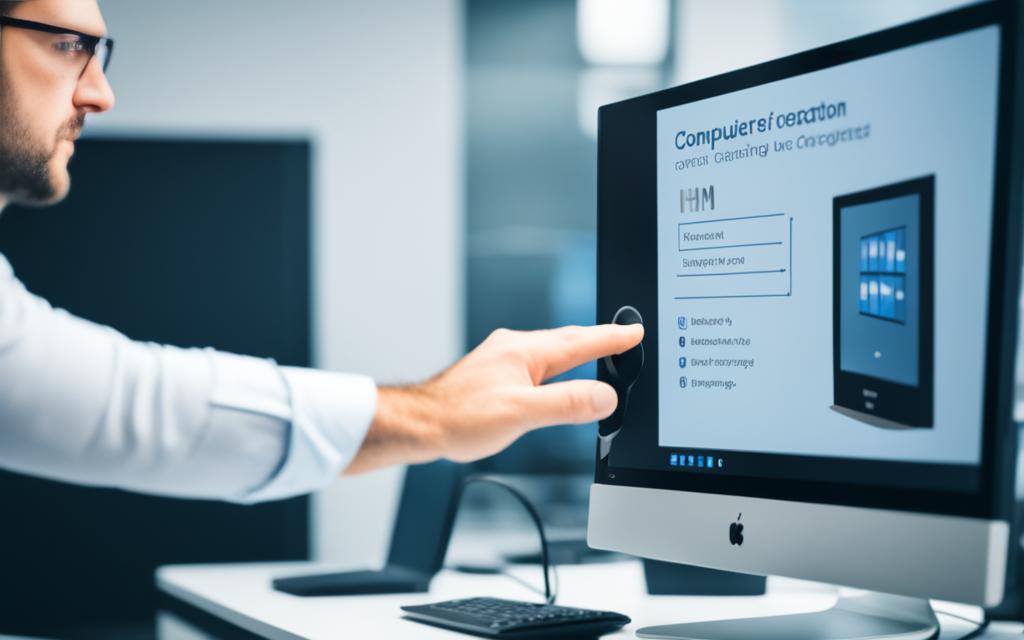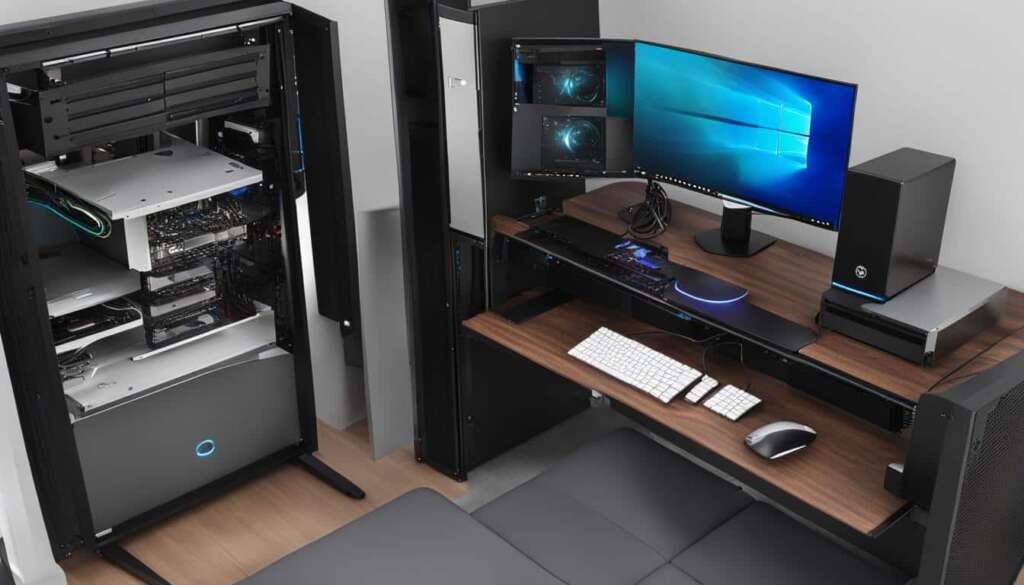Table of Contents
Switching your PC to HDMI lets you link it to an external display or TV. This improves how you see things. Our guide will show you several ways to do this on a Windows 11 PC. We’ll cover everything from plugging in the HDMI cable to tweaking your display settings for an easy HDMI switch.
Key Takeaways
- Switching to HDMI on your PC enables you to connect to an external display or TV, improving your visual experience.
- You can switch to HDMI on your PC by following our step-by-step guide, specifically tailored for Windows 11 users.
- Ensure you have the necessary equipment, including an HDMI cable and any potential adapters or software installations, for a smooth switching process.
- Adjust the resolution to fit your TV display, selecting the appropriate setting for HDTVs or 4K TVs.
- If encountering audio issues, access the Control Panel, select Sound, and navigate to the playback tab to ensure audio output is directed to the TV.
For more details on PC computers and their role in tech today, check out this page.
Reference:1
What You Need to Switch to HDMI
Before switching to HDMI on your Windows 11 PC, there are a few key things you’ll need2.
- A Windows 11 PC: The methods we will discuss are specific to this operating system.
- An HDMI cable: This cable lets you link your PC with an external display or TV. It boosts your viewing experience.
- An external display or TV: Ensure it has a HDMI input that’s ready to use and that it’s on.
Pick a high-quality HDMI cable for the best resolution and refresh rate. This choice promises top performance and a stable link.
Note that HDMI cables vary. The newest version, HDMI 2.1, supports even better features. It can handle 8K and variable refresh rates.
To get started with HDMI, simply have a Windows 11 PC, an HDMI cable, and an external display or TV2.
Key Aspects to Focus On
When you switch to HDMI on your PC, a few important points need your focus. First, you might have to adjust your computer’s graphics settings to turn on HDMI output. This involves setting the screen’s resolution and how it’s positioned3.
Next, to use your big screen or TV for sound, you’ll have to tweak the audio settings. Make sure the sound goes through the HDMI port. This lets you enjoy top-quality audio from your big screen4.
If you’re deciding on how to view your PC’s content, think about the display mode. You can either extend your PC’s screen to the big one or show the same thing on both. Extending gives you more room to work with different applications at the same time. But duplicating is great for when you’re showing something or enjoying movies45.
These points are vital in the HDMI switch process. They ensure your PC and big screen have the right graphics, sound, and viewing settings. Now, let’s look into the ways you can switch to HDMI in Windows 114.
HDMI Switch Options
| Switch Options | Port Capacity |
|---|---|
| 3-port HDMI switch | Accommodates up to 3 devices |
| 5-port HDMI switch | Accommodates up to 5 devices |
| 7-port HDMI switch | Accommodates up to 7 devices |
There are HDMI switches like 3-port, 5-port, and 7-port options for connecting many devices3. These switches let us link various HDMI devices to one HDMI input on our TV or big screen. Pick a switch that has enough ports for all your gadgets.
Having explored the essential aspects of HDMI switching, let’s now delve into how to activate HDMI output in Windows 11.
Method 1: Switching to HDMI Using Display Settings in Windows 11
To switch to HDMI in Windows 11, follow these steps. First, link your computer to the external display with an HDMI cable. Make sure the cable is properly connected to the HDMI ports6.
After making the connection, right-click on the desktop. Choose “Display settings” from the menu6.
You’ll see various options for display settings. Look for “Multiple displays.” There’s a drop-down menu to pick the display mode. Choose your external display from the list6.
You can also tweak the resolution for a better viewing experience. Pick a resolution that suits your screen and liking. Just select it from the options given6.
Once you’ve set the display and resolution, click “Apply.” Your PC will now use the HDMI connection for its display6.
If the screen doesn’t switch to HDMI right away, don’t worry. Press the “Windows” key plus “P.” This action brings up a menu. From there, choose the HDMI output6.
Remember, the display settings and its interface might look a bit different. This depends on your Windows 11 version and the graphics drivers installed on your computer.
Method 2: Switching to HDMI Via Graphics Control Panel
If your PC has a dedicated graphics card, you can use a graphics control panel to switch to HDMI. Here’s a simple guide:
- Right-click on the desktop and pick “Graphics Options” or “Graphics Properties” from the menu7.
- Go to the “Display” or “Output” section in the control panel7.
- Select the HDMI option from the list of outputs7.
- After saving your changes, your PC will use the HDMI output7.
The graphics control panel offers detailed control over your display settings. You can adjust brightness, contrast, and color to get the best picture7.
Adjusting the brightness through the graphics control panel can make your HDMI display brighter and clearer. It’s easy to get the perfect setting for your screen7.
You can also alter the contrast to improve how light and dark parts show. This makes details easier to see and enhances your viewing7.
Moreover, you can change the color balance settings. Adjusting color temperature, saturation, and hue ensures your display shows vibrant and true-to-life colors7.
With the graphics control panel, you’re in charge of your HDMI display’s settings. It lets you fine-tune your visual setup, whether for work, play, or relaxation. This way, your HDMI display will always deliver the best visuals for any situation7.
Method 3: Switching to HDMI Using the Project Menu
Windows 11 has a handy Project menu for quick HDMI changes. It lets you connect your PC to an external display or TV. The Project menu gives you power over different display modes for a better viewing experience. To use HDMI through the Project menu, do these:
- Hit the “Windows” key + “P” to bring up the Project menu2.
- Choose the HDMI option from the list. This action turns on the HDMI output. Your PC’s desktop will now show on the external display or TV2.
The Project menu smoothly switches you to HDMI. It also lets you pick from different display modes. You can extend the display, duplicate the screen, or make the external display your primary screen, depending on what you prefer2.
Finding the Project Menu in Windows 11
To find the Project menu in Windows 11, just press the “Windows” key + “P”. This shortcut quickly gets you to the Project menu. It helps you easily switch to HDMI and control your display settings2.
| Key Benefits of the Project Menu | How It Enhances Your HDMI Experience |
|---|---|
| Easy HDMI switching | The Project menu makes it straightforward to connect your PC to an external display with HDMI. You don’t need to adjust things manually2. |
| Display mode flexibility | Through the Project menu, you can choose a display mode that fits your needs. You can extend your desktop, duplicate the screen, or make the external display the main one2. |
| Effortless control | With Windows 11, managing your display settings is easy. It lets you smoothly switch between HDMI and other options2. |
By using the Project menu, you fully use your PC’s HDMI. You’ll get a smooth and engaging view on your external display or TV2.
Method 4: Switching to HDMI Using Display Drivers
If your graphics hardware has specific display drivers, you’ll find extra HDMI switching options. Here’s the process: Right-click the desktop and pick “Graphics Options” or “Graphics Properties” from the menu. Then, in the settings or control panel, go to the display or output area and select HDMI as the output8. After saving the changes, your PC will switch to HDMI. Display drivers let you access advanced settings for better HDMI performance and compatibility.
With display drivers, you can improve how you watch videos. They let you change settings like resolution, refresh rate, and color. These adjustments make everything on your screen look clear, colourful, and smooth.
Compatibility is key for HDMI switching. Using the right display drivers for your graphics card makes sure your PC and the HDMI display work well together. This helps avoid problems like flickering or weird-looking images.
To get the best experience, update your display drivers regularly. New updates fix bugs, boost performance, and improve how well your drivers work with HDMI. Check the manufacturer’s website, like Dell.com/support (source), for the latest drivers. By staying updated, you get better video quality and trouble-free HDMI use8.
Using display drivers for HDMI gives you more ways to fine-tune your setup, especially if you love games, create content, or want great visuals. With these drivers, you control how things look, ensuring top performance and smooth HDMI visuals.
| Advantages of Switching to HDMI using Display Drivers | Additional Display Options | Enhanced Compatibility | Optimized Performance |
|---|---|---|---|
| Access to advanced display settings | Customize resolution, refresh rate, and color calibration | Ensure seamless communication between PC and display | Minimize issues like flickering, tearing, or distorted images |
| Fine-tune parameters for clarity and vibrant colors | Adjust display orientation and scaling | Maximize compatibility with HDMI-connected devices | Experience smooth motion and high-quality visuals |
| Keep drivers up to date for bug fixes and enhancements | Unlock additional features specific to hardware |
Reference
| 1 | https://pcsite.co.uk/unlocking-pc-performance-tips-for-optimal-functionality-and-maintenance/ |
Conclusion
Switching to HDMI on your PC is easy and can make your videos look better. Just follow the guide in this article to connect your PC to a TV or monitor using HDMI. This will help whether you’re showing a presentation or watching movies. Learn how to switch to HDMI on Windows 11 for a better screen and visuals.
Using an HDMI cable is the best way to link your PC to a TV or another screen. HDMI, which means High Definition Multimedia Interface, is a common digital link for audio and video. It offers great picture and sound, boosting your viewing and listening experience. HDMI cables are both easy to get and affordable.
Windows 11 also lets you connect your PC to a TV without cables. Miracast is a wireless technology that mirrors your screen. Just open the Windows 11 Action Center and tap “Connect” to show your PC’s content on a TV. This way is flexible and simple, making it easy to watch movies and slideshows on a big screen.
Upgrading to a TCL XL collection TV can make your viewing even better. TCL is known for quality screens and the latest tech. Their XL TVs have amazing picture quality, brilliant colors, and great sound. This gives you a cinema-like experience at home. With TCL, dive into your favourite films, shows, and games. Enjoy endless entertainment and fun.
Click here to find out more about connecting your laptop to your TV via HDMI or wirelessly.
FAQ
What do I need to switch to HDMI on my PC?
You’ll need a Windows 11 PC, an HDMI cable, and an external display or TV. Make sure the display has an HDMI input.
What aspects should I focus on when switching to HDMI?
Focus on your graphics and audio settings. Also, think about your preferred display mode.
How can I switch to HDMI using the display settings in Windows 11?
First, connect your PC to the display with the HDMI cable. Right-click on your desktop and select “Display settings.”
Then, choose the external display. Adjust its resolution and save your settings.
How can I switch to HDMI via the graphics control panel?
Right-click the desktop and select “Graphics Options” or “Graphics Properties.” Go to the “Display” or “Output” section.
Choose the HDMI option there and save your settings.
Press “Windows” key + “P”. Select the HDMI option from the list. Your PC will then switch to HDMI.
This will match the display mode you selected.
How can I switch to HDMI using display drivers?
Right-click on the desktop, and select “Graphics Options” or “Graphics Properties.” Head over to the display or output section.
Then, choose the HDMI option and save your choices.
Why should I switch to HDMI on my PC?
Switching to HDMI lets you connect to a bigger screen. This means better visuals and a larger display for your PC.
Source Links
- https://www.wikihow.com/Connect-PC-to-TV-with-HDMI – How to Connect PC to TV with HDMI: 8 Steps (with Pictures)
- https://www.iseepassword.com/blog/how-to-switch-to-hdmi-on-pc-windows-11/ – How to Switch to Hdmi on PC Windows 11 – iSeePassword Blog
- https://ventiontech.com/blogs/technology-overview/how-do-hdmi-switches-work-a-quick-guide – How Do HDMI Switches Work: A Quick Guide
- https://www.techsolutions.support.com/how-to/how-to-connect-a-windows-laptop-to-a-tv-over-hdmi-12554 – How to Use HDMI: Laptop to TV – Support.com
- https://us.seenebula.com/blogs/how-to-select/how-to-connect-laptop-to-projector-with-hdmi – How to Connect Laptop to Projector with HDMI: Step-by-Step Instructions
- https://community.zoom.com/t5/Zoom-Meetings/Dual-Monitor-Setup-Zoom-disagrees-with-Windows-11-as-to-which-is/m-p/51899 – Zoom Community
- https://www.intel.com/content/www/us/en/tech-tips-and-tricks/entertainment/how-to-connect-a-laptop-to-a-tv.html – How to Connect Laptop to TV: HDMI Port Tips and Tricks | Intel
- https://www.dell.com/support/kbdoc/en-us/000132424/how-to-connect-a-monitor-to-a-pc – How to Connect a Monitor to a Dell Computer








